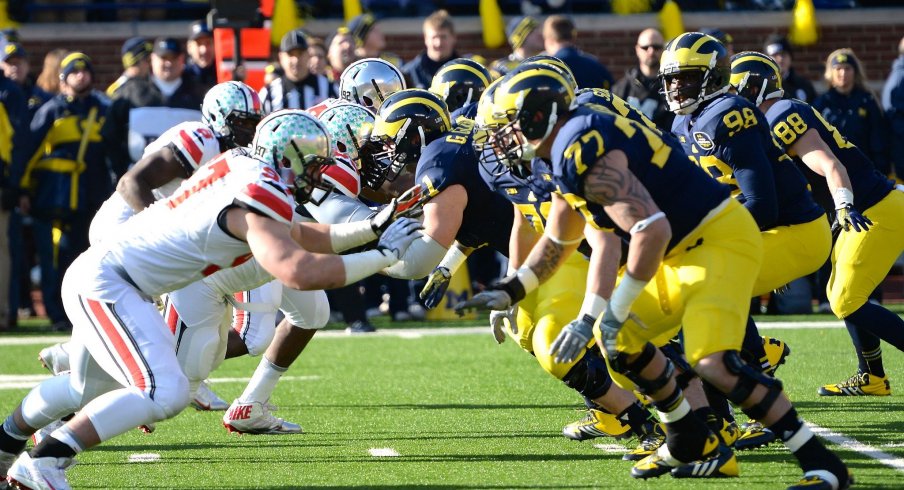Three-star in-state linebacker CJ Sanna commits to Ohio State.
2013 was a year to forget for football fans in Ann Arbor. 2014 has been even worse.
Coming off a seven-win season, expectations for the Maize and Blue were lower than usual, as fans hoped to see development from a young squad that was replacing only one major playmaker in receiver Jeremy Gallon. With consistent success on the recruiting trail during his tenure as head coach, Brady Hoke appeared to have the pieces needed to take a step forward this fall.
After replacing oft-criticized offensive coordinator, Al Borges with Doug Nussmeier, who had been in the same role at Alabama, many expected the offense to not only develop, but also find an identity that had been missing since the departure of Hoke's predecessor, Rich Rodriguez. Instead, the same issues that consistently popped up in the Big House over the past two seasons continued to rear their ugly head yet again.
While Hoke has regularly been questioned about his decision not to wear a headset on the sideline during games, his most blatant coaching failure has been an inability to develop offensive talent. After consistently bringing in blue chip talent, especially on the offensive line, the Wolverines rank as one of the worst offenses in the country.
The story has been brighter on the defensive side of the ball, where veteran coordinator Greg Mattison has done just the opposite, fostering a unit that is fundamentally sound and aggressive. Mattison's crew has statistically been one of the best in the nation, showing few major weaknesses keeping opposing big plays to a minimum.
But in the modern era of College Football, defense alone doesn't win championships, as the maize and blue carry a 5-6 record into Columbus for their season finale. As the leadership of the athletic department in Ann Arbor appears to be solidifying, it's all but guaranteed that the matchup with Ohio State will be Hoke's final game in charge.
While this rivalry has seen teams rally to a win behind embattled coaches before, the visitors will have to produce their best performance of the year by far to pull off the upset.
Offense
After three years under center, the Devin Gardner experiment is sadly finally coming to an end. The former five-star recruit from Detroit was the crown jewel of Rodriguez's recruiting efforts, expected to be the immediate face of the program while breaking down the stereotypes of what it took to play quarterback in the mitten state.
But after suffering an injury as a freshman and temporarily moving to wide receiver while Denard Robinson re-wrote the record books at the QB position, Gardner never reached his full potential. It appears that he's actually regressed since taking over for Robinson in 2012, seeing his efficiency numbers decline while his interception totals have grown each year.
After more injuries and a temporary benching due to ineffectiveness last month, Gardner appears to be totally lacking in confidence when it comes to throwing the ball these days. That shakiness is likely due the fact that his offense has still yet to find any concepts upon which they can rely when they need to pick up yardage, a problem that clearly isn't all the fault of Borges.
The Wolverine offense continues to embrace the "grab-bag" approach that hurt them in the past, even though they've finally found a consistent group of starters on the offensive line. The "master of nothing" label has continued to stick to Gardner's protectors up front, leaving Nussmeier with little foundation to build a game plan upon each week.
These problems are only amplified by the "running back by committee" approach taken in the backfield, which has had to deal with the injury to opening day starter Derrick Green. The current flavor-of-the-week appears to be Drake Johnson, who is coming off a 94-yard performance one week ago against Maryland. But the Ann Arbor native will share carries with junior Justice Hayes, the Wolverines' best back in space, and fellow sophomore De'Veon Smith, who gets the bulk of carries in short yardage situations.
With so many blocker and ball-carrier combinations, it's no surprise that Nussmeier doesn't rely on one specific scheme when looking to run the ball, calling a mixture of inside and outside zone blocking, as well as multiple gap-blocking concepts such as power. But with an athlete like Gardner in the backfield, he's often given the option to read an unblocked defender and keep the ball to run for himself.
Although Gardner hasn't recorded a 100-yard rushing game in over a year, these read-option plays are actually the most effective runs in the maize and blue offense, thanks mostly to the fact that the option component effectively blocks an extra defender, which helps the embattled offensive line.
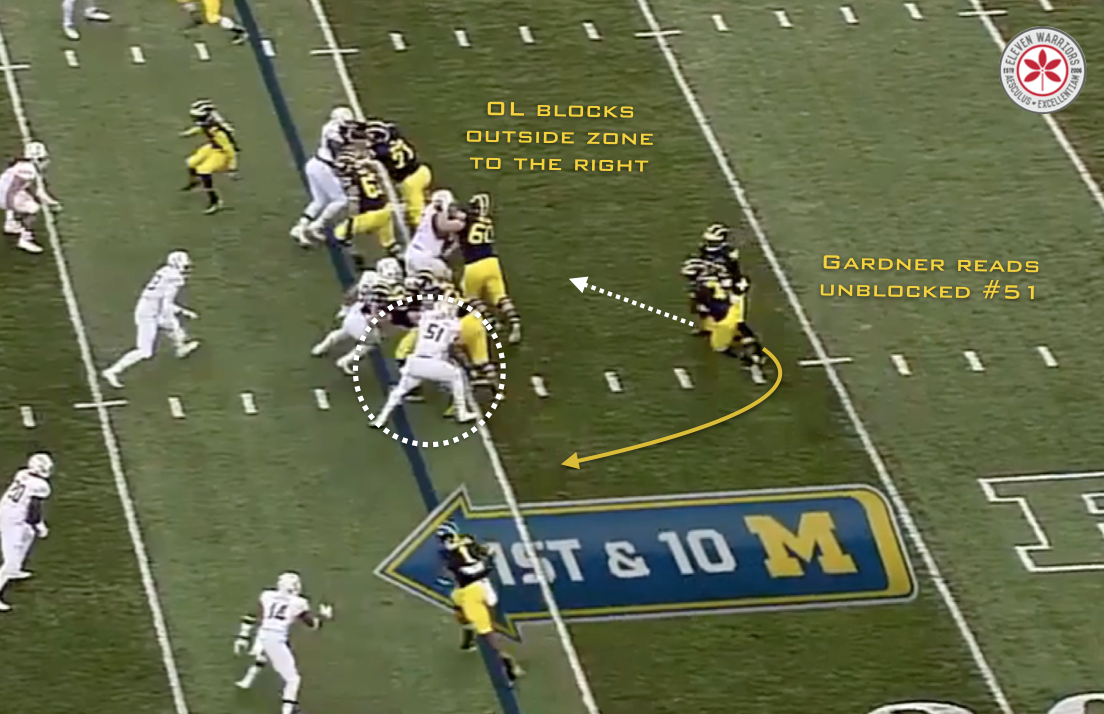
The most consistent piece of Nussmeier's game plans have been the focus on getting the ball to receiver Devin Funchess. After a breakout 2013 campaign where he gained over 700 yards through the air and found the end zone six times, many looked at the converted tight end as one of the best NFL prospects in the Big Ten.
At 6'5" he is already a matchup nightmare for most defensive backs, but Nussmeier does his best to find ways to get him open. One of the most well-known concepts is their longtime use of the stack formation, which lines up one receiver directly behind another, not allowing defenders to know who they're covering before the ball is snapped. Though often written off as a gimmick, the stack has proven to be effective against teams that employ Cover 4 technique, which happens to be what the Buckeyes run as their base scheme.

When in that coverage, defenders are responsible for receivers based on their release after the snap. By effectively running a defender off with the front receiver, Funchess appears as if he's releasing toward another direction before cutting toward that now-vacant area. There are a number of route combinations that can achieve this result, but Funchess and Gardner appear to be most comfortable when attacking the cornerback with an out pattern.
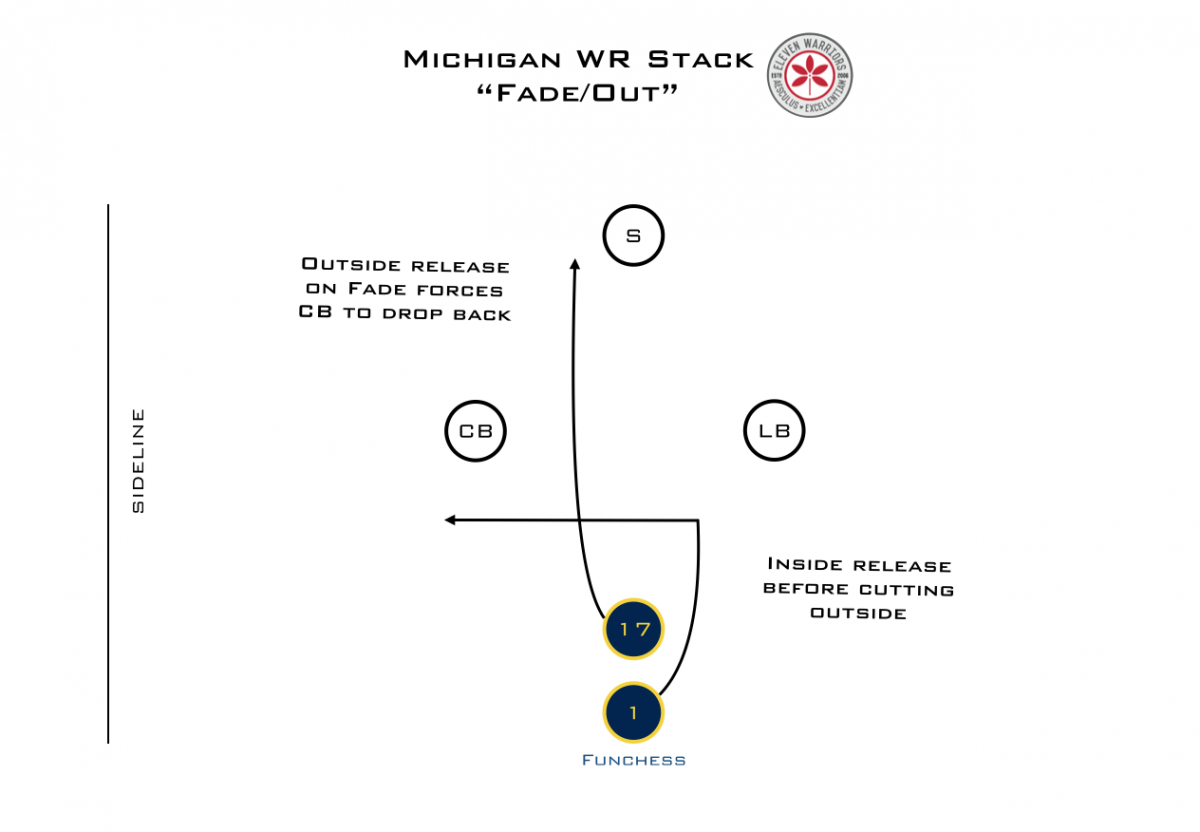
But although he's eclipsed his catch total from 2013 already, Funchess hasn't been as effective this year. While it's hard to say for sure, since the stat isn't kept regularly at the collegiate level, the film shows that Funchess rarely gains many yards after the catch. With the exception of a 43-yard touchdown pass that should've been intercepted against Penn State, his only TD since week one against Appalachian State, he hasn't had a reception of more than 24 yards in conference play.
Funchess' underwhelming performance underscores a much larger problem for Hoke's offense, who have been one of the worst units in the country at creating big plays.
For those that remember the 2011 Buckeyes' offensive struggles, they were caused mostly by issues in the scheme, as many of the same players on that team would contribute to the record setting offenses that would come in the following seasons. Most notably that team didn't properly embrace the constraint theory of play-calling, which means that plays like screens, counters, and play-action passes are there to keep defenses from over-playing the base run and pass plays that a team can execute in their sleep.
Without any base schemes to rely upon, Nussmeier is forced to use these constraint plays out of nowhere, simply hoping they can out-execute their opponent, even though they aren't set up for it. Usually a team will run play-action off a faked run play once that play has worked multiple times and the defense is looking for it.
But if the defense isn't looking for that play, then the offense is simply trying to execute a play that's more difficult. One such example would be running a faked jet sweep to give Gardner a simple run/pass option with Funchess on a rollout, without having run the jet sweep before.
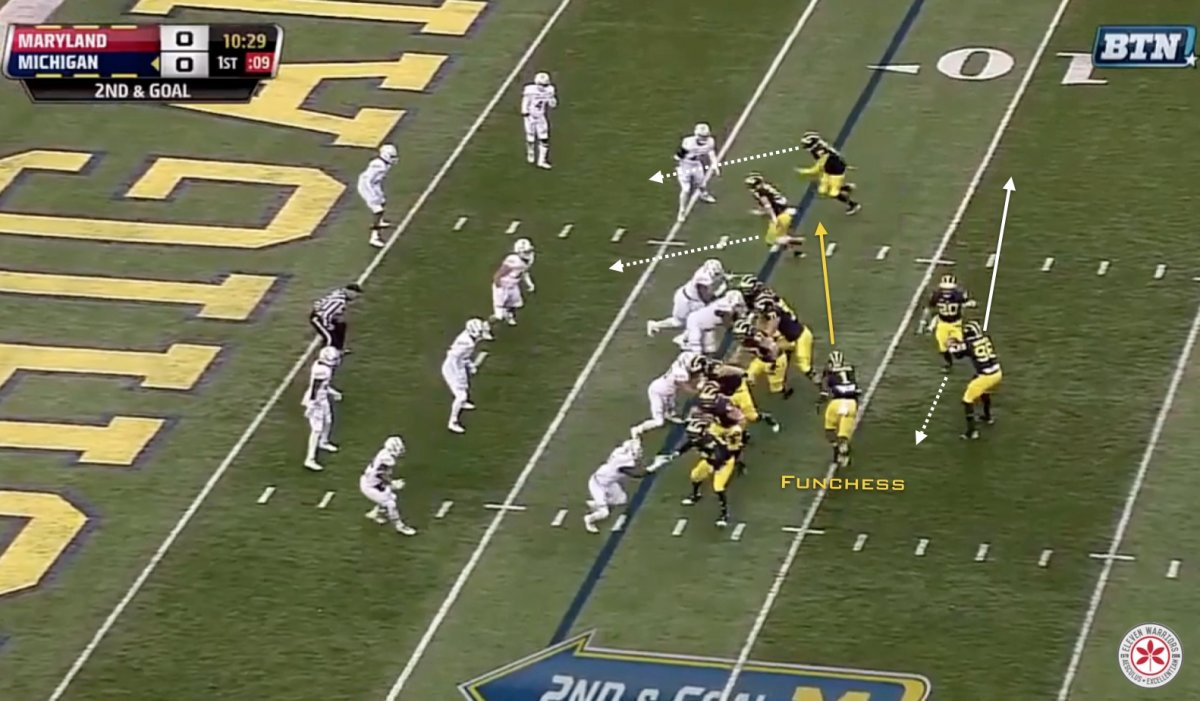
But since they're spending so much time trying to practice complex, gadget plays like this, Gardner and company have shown a consistent inability to execute during games. Gardner, especially has been very inconsistent with his accuracy, which has led to many of those interceptions, like this back-breaker against Michigan State.
But this isn't all Gardner's fault. Few players have emerged around him that can make plays on their own. None of the running backs have shown big play ability against decent competition, and Funchess used to line up next to the tackles, after all. Players like Amara Darboh, Jehu Chesson, and Dennis Norfleet have hardly made an impact at the receiver spot, giving Gardner few options to which he can turn when looking for a big play.
Yet many of these same issues were present a year ago when the Buckeyes gave up 41 points in Ann Arbor to this team. Borges cooked up a game plan then that embraced the constraint theory, building a series of plays off one another, and taking advantage of any Ohio State mistakes.
But with a defense that has tightened up a great deal on the back end thanks to coordinator Chris Ash, it's hard to see a scenario where Ohio State gives up many points on Saturday.
Defense
In the Rodriguez era, the maize and blue cycled through multiple defensive schemes and coordinators, but have built a strong philosophical foundation in the past four seasons under Mattison. Unlike their counterparts on the offensive side of the ball, his defense has done an excellent job of building an identity over the past few years, which allows them to make the subtle tweaks each week needed to stop an opponent without sacrificing fundamentals.
Playing out of a base 4-3 Under system with three true linebackers, the defense focuses on stopping the run and playing aggressively up front, hopefully forcing third-and-long situations where Mattison can call an array of blitzes with the linebackers or secondary.
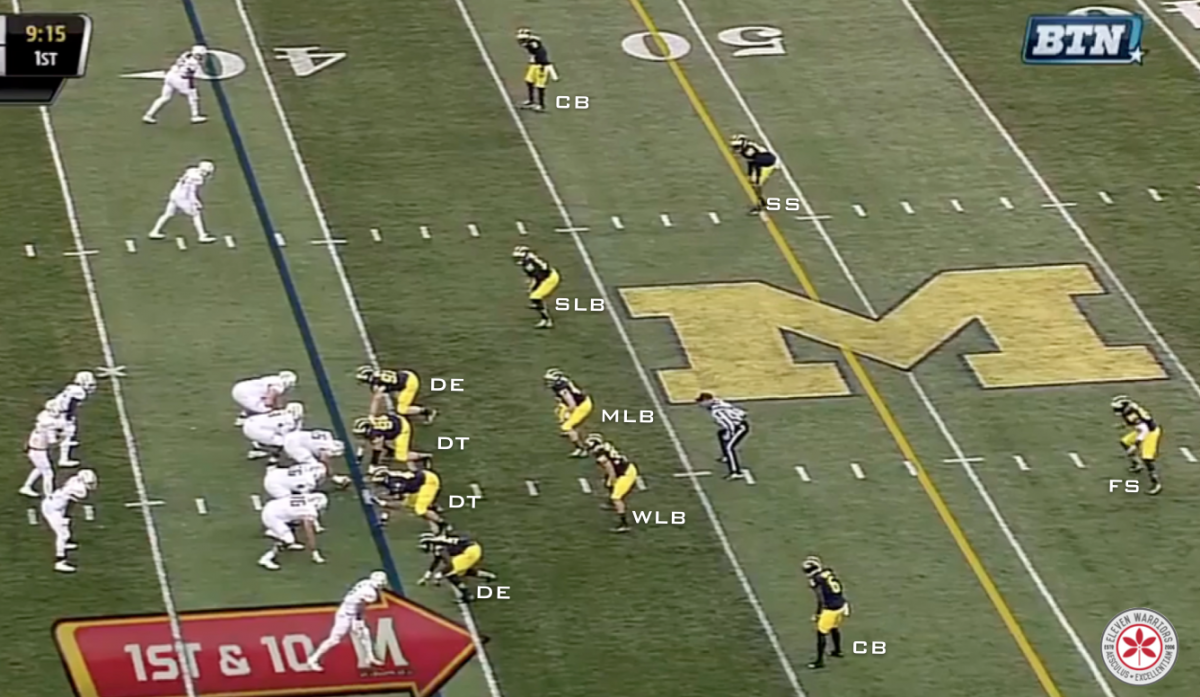
Much like the Buckeyes, they'll show a cover 4 shell before the snap, but will mix in man coverage as well as the occasional, three-deep zone on long third downs.
While many defenses attempt to cause problems with their defensive line, allowing their middle and weakside linebackers to make the majority of the tackles, Mattison has done an excellent job of teaching technique to his big men up front, a group far less heralded in recruiting circles than their opposite numbers on the offensive line. Though they've been led by defensive tackles like Mike Martin in the past, this year's group relies heavily on the defensive ends to cause problems in opposing backfields.
This isn't just a group that eats up blockers, though. They are excellent at using their hands to fight off blockers, often making enough contact in the backfield for linebackers Jake Ryan and Joe Bolden to come downhill and finish off the play.
But this group took a major hit last week when senior end, Frank Clark was dismissed from the team. Clark was their best pass rusher, and was third on the team in tackles at the time of his departure. In his place, DL coach Mark Smith rotates Mario Ojemudia and Taco Charlton, with the latter often taking the majority of snaps on passing downs.
At 6'6" and 275 lbs, Charlton is an impressive athlete who has shown flashes of huge potential at times this fall. But he is clearly still learning the nuances of the position, and could be a target for the Buckeye running game Saturday, especially in double-team situations.
But Mattison's defense has had trouble getting to the quarterback, even when Clark was on the field. Though they rank in the middle of the Big Ten in sacks, 12 of their 29 takedowns occurred in matchups with Penn State and Northwestern, two of the worst teams in the country at protecting their signal callers.
Without a marquee pass rusher to rely on, Mattison is forced to bring additional pressure in hopes getting to the QB. One of his favorites is the "NCAA blitz" from the wide side of the field, bringing the strongside and middle linebackers around edge after slanting the defensive line to the boundary.
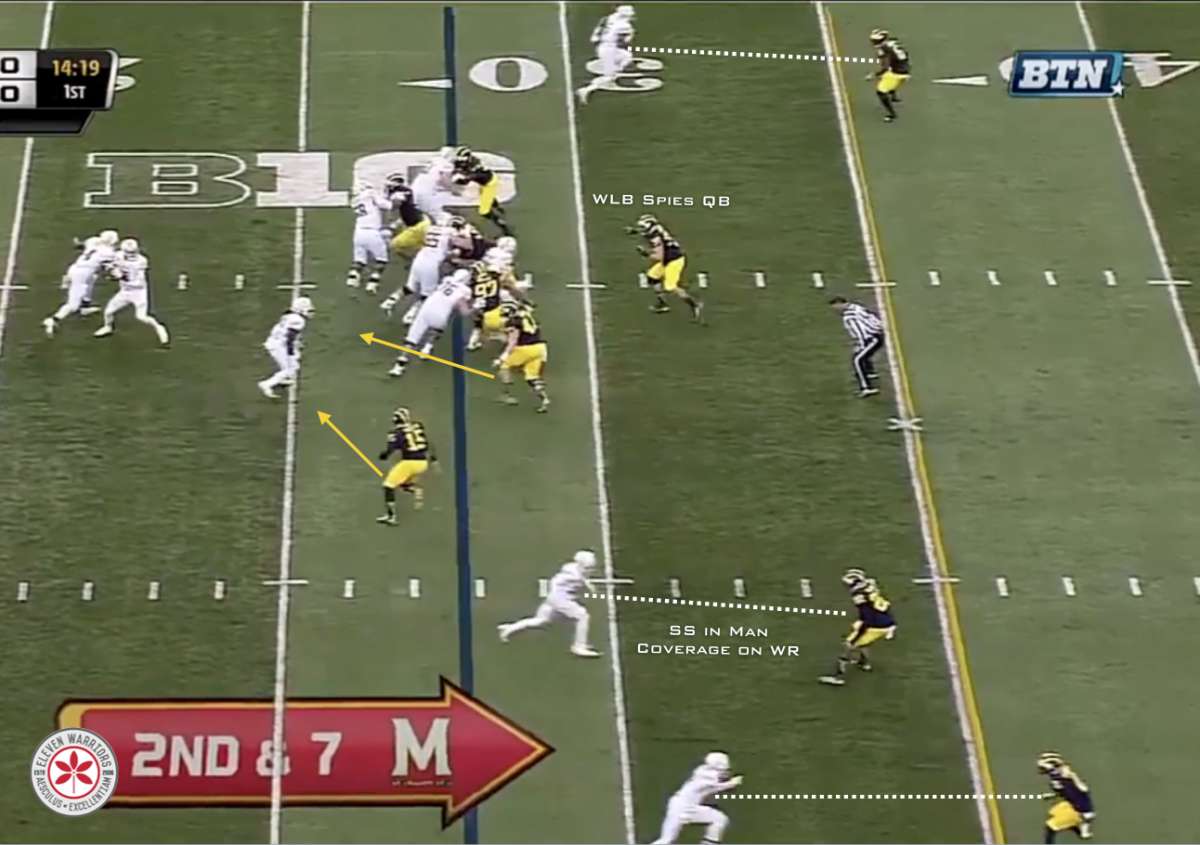
While this blitz certainly stresses the pass protection of their opponents, it often forces their safeties, specifically strong safeties Jarrod Wilson and Delano Hill, into man coverage situations with opposing wide receivers. Much like the rest of the defense, Wilson and Hill are good tacklers who don't make many mistakes when flowing downhill to make tackles in the run game. But one-on-one pass coverage is a totally different ballgame, and one where these two have had problems keeping up with talented wideouts.
Identifying these man-coverage situations will be key for J.T. Barrett and the Buckeye offense. With Jalin Marshall improving each week as a slot receiver, Ohio State should have a clear advantage if they're able to get him in single coverage with a safety.
Additionally, if OSU is able to move the ball on the ground regularly, Mattison will be forced to call these blitzes on early downs to help slow down the running game. If that is the case, keep an eye on what personnel is lined up in the slot, as the Buckeyes make try to take a deep shot on a safety with Devin Smith there, as they did against Michigan State.
But as has been the case recently, Barrett's abilities as a runner may be too much for the maize and blue to handle. Maryland quarterback C.J. Brown picked up bug chunks of yards on both scrambles and option runs last week, piling up 87 yards. Although Ryan and Bolden are excellent tacklers that rarely miss once they get their hands on the ball carrier, they're much better at moving forward to make a play than they are moving laterally.
Plays like a read-option off the tight zone like we saw in overtime against Penn State, or the faked speed option pitch that led to a cutback against Minnesota are likely to be on Tom Herman's play calling sheet Saturday, as they do an excellent job of getting the defensive front moving in one direction before Barrett takes off in the other.

Braxton Miller had a number of big runs in last year's game, picking up 153 yards on the ground and finding the end zone three times against many of the same players. Though Mattison and Hoke will do their best to coach up their guys to prevent these big plays, the Buckeyes have a distinct athletic advantage when these two units are on the field, something that can't be taught.
Such a paradox truly encapsulates the Hoke era in Ann Arbor. One on side of the ball, he has brought in some of the highest regarded players in the country, but has failed to develop them once they arrived. On the other side, they've done an outstanding job teaching a bunch of guys that were passed over by the top schools, many of them in Ohio. But players like Ryan and Bolden weren't recruited to be Buckeyes for a reason.
In what will likely be their last game coaching these players, Hoke and Mattison will likely be as aggressive as ever. But since execution trumps scheme once the ball is snapped, the Buckeyes should still be able to put enough points on the board to distance themselves from the struggling maize and blue offense.
